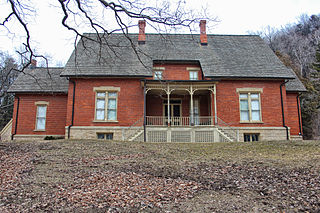
Stonefield, located at 12195 County Road VV outside Cassville, Wisconsin, United States, was the 2,000-acre (800-hectare) estate of Wisconsin's first governor, Nelson Dewey. Much of the original estate has been separated into Nelson Dewey State Park and the Stonefield historic site, an expansive museum operated by the Wisconsin Historical Society. The historic site takes advantage of the large property by offering several different areas for visitors, including an early Wisconsin farmhouse, a re-created agricultural village built to resemble those common around 1900, and a reconstruction of Nelson Dewey's home. Stonefield is also home to the Wisconsin State Agricultural Museum, which features a large collection of antique farm equipment.

The Timucuan Ecological and Historic Preserve is a U.S. National Preserve in Jacksonville, Florida. It comprises 46,000 acres (19,000 ha) of wetlands, waterways, and other habitats in northeastern Duval County. Managed by the National Park Service in cooperation with the City of Jacksonville and Florida State Parks, it includes natural and historic areas such as the Fort Caroline National Memorial and the Kingsley Plantation.

The Judah P. Benjamin Confederate Memorial at Gamble Plantation Historic State Park, also known as the Gamble Mansion or Gamble Plantation, is a Florida State Park, located in Ellenton, Florida, on 37th Avenue East and US 301. It is home to the Florida Division United Daughters of the Confederacy (UDC).

Ridley Creek State Park is a 2,606-acre (1,055 ha) Pennsylvania state park in Edgmont, Middletown, and Upper Providence Townships, Delaware County, Pennsylvania in the United States. The park, about 5 miles (8 km) north of the county seat of Media, offers many recreational activities, such as hiking, biking, fishing, and picnicking. Ridley Creek passes through the park. Highlights include a 5-mile (8 km) paved multi-use trail, a formal garden designed by the Olmsted Brothers, and Colonial Pennsylvania Plantation, which recreates daily life on a pre-Revolutionary farm. The park is adjacent to the John J. Tyler Arboretum. Ridley Creek State Park is just over 16 miles (26 km) from downtown, Philadelphia between Pennsylvania Route 352 and Pennsylvania Route 252 on Gradyville Road.

Dudley Farm Historic State Park (Florida), also known as Dudley Farm, is a U.S. historic district and museum park located in Newberry, Florida. It was added to the U.S. National Register of Historic Places on October 4, 2002, and was designated a National Historic Landmark in January, 2021. The address is 18730 West Newberry Road. The farm is a particularly fine and well-preserved example of a mid-19th to mid-20th century farm.

The Krueger House is a historic house in Stuart, Martin County, Florida. It is located on the grounds of the historic Burn Brae Plantation. On February 14, 2002, it was added to the U.S. National Register of Historic Places.

The Jarrell Plantation State Historic Site is a cotton plantation and state park in Juliette, Georgia, United States. Founded as a forced-labor farm worked by the Jarrell family and the black people they enslaved, the site stands today as one of the best-preserved examples of a "middle class" Southern plantation. The Jarrell Plantation's buildings and artifacts all came from the Jarrell family, who farmed the land for over 140 years. Located in the red clay hills of the Georgia piedmont, It was added to the National Register of Historic Places in 1973. It is a Georgia state park in Jones County.

DeBary Hall is a historic site in DeBary, Florida, United States. It is located at 198 Sunrise Boulevard. On July 24, 1972, it was added to the U.S. National Register of Historic Places. Frederick DeBary was a wine importer for Mumms Champagne and built DeBary Hall in 1871 as his hunting retreat along the St. John’s River in central Florida. The area offered various leisure activities such as swimming in the local springs, fishing, and hunting quail, deer, and alligator.

The Epping Forest was a historic, 58-acre (230,000 m2) estate in Jacksonville, Florida where a luxurious riverfront mansion was built in the mid-1920s by industrialist Alfred I. du Pont and his third wife, Jessie Ball du Pont. It was added to the U.S. National Register of Historic Places in 1973 and has been restored to its original grandeur as the home of the Epping Forest Yacht Club. On April 18, 2012, the AIA's Florida Chapter placed the Epping Forest Yacht Club on its list of "Florida Architecture: 100 Years. 100 Places".

The Pryor Brock Farmstead is a place on the National Register of Historic Places just west of Zionsville, Indiana, comprising 4.9 acres (20,000 m2) of what was once a 200-acre (0.81 km2) farm. It was placed on the Register, June 27, 2008, due to its role in the agricultural history of Eagle Township, Boone County, Indiana. Pryor Brock Farmstead, with its carpenter's rendering of Italianate architecture, is the best representation of the prosperous agricultural setting around Zionsville/Eagle Township during its time of significance (1870-1920), the "golden age" of Hoosier agriculture.
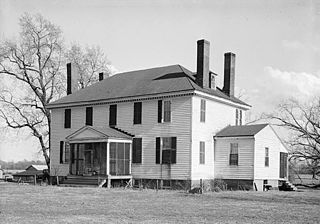
Weyanoke is a plantation farmstead in Charles City County, Virginia, United States. In 1619 the English transported African slaves to the Weyanoke Peninsula. They created the first African community in North America. The Westover Plantation and related archaeological sites were listed on the National Register of Historic Places in 1980.

Cobblestone Farmhouse at 1229 Birdsey Road is a farmhouse in the town of Junius, New York, in Seneca County, New York. It is significant as a well-preserved example of cobblestone architecture, in a vernacular Greek Revival style. North of the house, there is also a large barn believed to date to the late 19th century. This property was listed on the National Register of Historic Places on August 6, 2008. It is the sixth property listed as a featured property of the week in a program of the National Park Service that began in July, 2008.
The Swedish American Farmsteads of Porter County, Indiana are representative of the numerous rural communities settled by a significant ethnic population. They influenced the religious community and social community. This collection is the most complete early 20th century complex within the Swedish cultural landscape of Baileytown and has retained a great deal of integrity.

Peter Peterson Farmstead, also known as Emel Peterson Farmstead, near Waverly, Nebraska, United States, dates from 1893. It was listed on the National Register of Historic Places in 1980.

The Christopher C. Walker House and Farm is a historic farmstead in the far western part of the U.S. state of Ohio. Located southwest of the village of New Madison along State Route 121, it is composed of five buildings and one other structure spread out over an area of nearly 160 acres (65 ha).
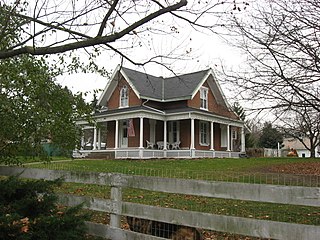
The Fulton Farm, also known as "River Bend Farm," is a historic farmstead in Shelby County, Ohio, United States. Located on the southern side of the city of Sidney, the farm is composed of five buildings spread out over an area of approximately 2 acres (0.81 ha). Built primarily in 1848, the distinctively Gothic Revival farm buildings are a leading element of Shelby County rural architecture; few pre-Civil War farmhouses elsewhere in the county are more elaborate. Besides the farmhouse, the complex includes four less important buildings, two brick and two wooden: a smokehouse, a carriage house, and two smaller barns.
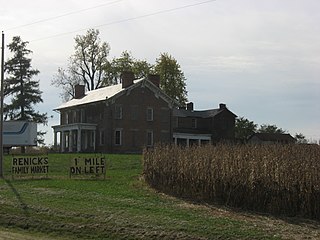
The Renick Farm is a historic farmstead located along U.S. Route 23 near the village of South Bloomfield in northern Pickaway County, Ohio, United States. Composed of six buildings dating back to 1830, the farmstead has been designated a historic site because of its unusually well-preserved architecture.

The Charles C. Fitch Farmstead is a historic farm property located in Eugene, Oregon. It was listed as a historic district on the National Register of Historic Places (NRHP) on June 16, 1989.
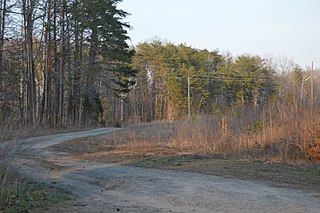
The Collins Ferry Historic District encompasses two historic farmsteads, as well as a mill and ferry site on the Staunton River in rural northern Halifax County, Virginia, west of Brookneal. The district covers 768 acres (311 ha), extending south from the river roughly to Bull Creek Road, and westward from the mouth of Buffalo Creek, which roughly bisects the district. The Collins Farm, which is located at the end of McKeever's Trail, includes one of Halifax County's best-preserved Federal style plantation houses, built c. 1810 and located on a bluff overlooking the creek. The Collins Farm includes 19th century farm outbuildings, the family cemetery, a mill site along the river, and the site where stones for the mill's construction and grinding stones were quarried. The Hubbard Farm is located south and east of the Collins Farm, and is accessed via a private drive that forms part of the historic road leading to Collins Ferry. Hubbard Farm includes a Greek Revival farmhouse built in 1856, and also includes 19th century outbuildings, a family cemetery, and the remains of a slave quarters.
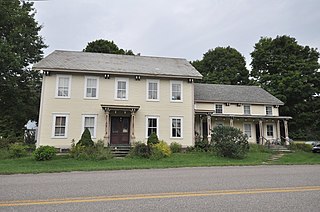
The Martin M. Bates Farmstead is a historic farm property on Huntington Road in Richmond, Vermont. Farmed since the 1790s, the property is now a well-preserved example of a mid-19th century dairy farm, with a fine Italianate farmhouse. The property was listed on the National Register of Historic Places in 1991.





















